Abstract
This paper presents a novel exoskeleton robot that can be used at home to rehabilitate the index fingers of stroke-affected patients. This exoskeleton is designed as a one-degree-of-freedom four-bar mechanism able to guide the human index finger to perform a finger curl exercise motion. The proposed device is the only lateral, stand-alone mechanism built to date that can carry the weight of the human hand, thus making the user free from wearing it. The design starts by tracing the trajectory of the index finger using ‘Angulus’ software. ‘SALAR Mechanism Synthesizer’ software is used for dimensional synthesis of the four-bar mechanism. Using additive manufacturing technology, a prototype of the proposed device is developed. Static force analysis is performed to select the most appropriate actuator for producing the required torque to manipulate the fingers effectively. The kinematics of the index finger while performing a finger curl exercise is obtained. The proposed linkage mechanism can drive the index fingers of both hands. Simulation and experimental results proved the feasibility and effectiveness of the proposed design to be used for index finger rehabilitation for a wide range of users and applications by making simple minor alterations in the design. Also, a scheme for when the device can be used for rehabilitating the middle finger together with the index finger when performing flexion and extension motions is discussed.
1. Introduction
When the flow of blood through the brain nerves is interrupted or blocked, the brain becomes dead and, as a result, one side of the body including the hand associated with the dead brain hemisphere becomes paralyzed. This brain attack is called a stroke, and 80% of stroke patients show upper limb malfunction, and 20% show full body. To regain the lost strength of the body, conventional methods involve physical rehabilitation in the presence of a physiotherapist. Nowadays, due to a shortage of trained physiotherapists and financial difficulty, robotic technology is trying to bridge this gap [1].
In stroke patients, the first three months are a golden period. During this period, motor recovery will be easy if rehabilitation is performed well. For less than a month, they stay at hospitals and, for the next two months, they stay at home. In records, only 20% of patients go back to the original state after stroke because they are financially independent to receive better treatment. This means that 80% of them sit at home but have the potential to get back their functional activity. The guidelines say, rehabilitation needs to be intense and has to be performed several times a day in cycles.
Inviting a physiotherapist home is very expensive. It has also been seen in the past that due to COVID-19 lockdown restrictions, many stroke-affected patients are unable to go to primary health centers for rehabilitation treatment. Hence, the focus of the research is to build a small system that they can carry home to perform rehabilitation. Kids also have a chance of stroke. Rehabilitation is also important for kids with cerebral palsy. Hence, the need to build a system that can be customized easily for any age group is also essential.
Most researchers have focused on developing wearable robots for lower limbs like assistive robots, which could help disabled persons to walk [2]. The hand is the most difficult part to regain strength after a stroke. Researchers do not spend much time on the hand. Research says “if there is a wrist rehabilitation robot, it will improve the wrist and elbow motions of the patients and if there is a robot only for elbow then it will only improve the elbow motions”. Hence, “if trained the hand (wrist and fingers) it will benefit the whole upper limb”. Humans mainly use their index, middle, and thumb fingers for performing activities of daily living (ADL) [3]. So, an exoskeleton robot for the index and middle fingers is the focus of the research.
Exoskeleton robots are built for applications like rehabilitation, motion assistance, exercising, and supporting human capabilities. In the medical field, robots are used for performing rehabilitation therapy in stroke-affected patients. Several upper limb exoskeleton robots have been proposed in recent years for rehabilitation assistance. An exoskeleton robot is a man-machine intelligent system. It combines human intelligence and machine power to its utmost potential. It is an orthotic device with joints and links that correspond to human joints and links [4].
The exoskeleton’s activity category divides the kind of assistance it provides to the user into active and passive. The active class includes exoskeletons that perform movements without the need for human physical energy. An external source, such as an electric motor, provides the energy required to carry out the movement. Exoskeletons in the passive class, on the other hand, require the user to move and have no power sources. As a result, the user must accomplish the movement, and the exoskeleton assists them in doing so [5]. The focus of this project is toward active exoskeleton as the user is a stroke-affected patient having no potential to exert power.
The active exoskeleton robots may be classified as follows: (1) the applied upper limb segment (hand, forearm, and upper arm), (2) the number of degrees-of-freedom (DOF), (3) the actuators used (pneumatic, electric, or hydraulic), (4) power transmission methods (linkage mechanism, gear drive, cable drive), and (5) robot application (rehabilitation robots, assistive robots, human amplifier, combined use) [4].
This paper concentrates on the mechanical design of an active exoskeleton robot using electric actuators to actuate a one-DOF linkage mechanism for power transmission. Power transmission is more efficient when using linkages than gear drive and cable drive. More specifically, the focus will be on the four-bar linkage mechanism as it is the simplest closed-loop mechanism with a minimum number of links and joints that can generate the human index fingertip path. Also, direct drive motor actuation (only rotary actuators) is employed in this work as an indirect drive motor can increase the number of components and design complexity. Also, rotary motors are easy to control and are compact and lightweight [1]. Some researchers have tried to use serial manipulators, which are bulky in their design and they do not look like anthropomorphic exoskeletons [3].
The need for robotic devices for home rehabilitation is gaining traction these days as it avoids patient dropouts due to transportation, travel, and insurance constraints [6]. The applicability of the proposed device will be advantageous as it can be used at home. The proposed device performs rehabilitation exercises very accurately, precisely, and in a repetitive manner without causing damage to any part of the human hand. The proposed device is useful for those patients who cannot financially afford a physiotherapist at home. This device is built specifically for finger rehabilitation in a cost-effective manner.
The proposed device is a stand-alone mechanism as it is not attached to any part of the hand. In this case, the patient who uses the device does not feel any weight of the device acting on any part of the hand. There is also a need to design a device that can perform some prescribed hand exercises in patients as suggested by a clinician like the ‘finger curl’ exercise. Usually, all existing devices perform motions that the human fingers perform such as finger flexion/extension motion or abduction/adduction motion. The proposed device performs finger curl exercise as it is the most effective exercise for building strength and dexterity in fingers.
There is also a need to develop a device that can be used for both hands without altering the design. This device performs finger curl exercises for index fingers. This device also is well suited for both the index and middle fingers when performing flexion and extension motions. Unlike existing devices that require the aid of computers and programming, this device does not need any of these as it is preprogrammed in Arduino Uno microcontroller board and can be powered from any USB port or any external portable battery charger. The proposed device comes up with an effective robot-aided finger rehabilitation by providing natural movement for all joint motions of the index finger far from other devices that only perform a range of motion (ROM) for the metacarpophalangeal (MCP) joint of the index finger.
The main purpose of this research is to develop a new robotic technology for the physical rehabilitation of stroke patients, thereby regaining muscle strength. This robotic device can help the patient’s paralyzed finger to perform prescribed exercises such as a finger curl exercise. This concept of conducting prescribed exercises indicated by the physician is seen as the most unique aspect of the proposed device when compared to similar existing devices that just execute fundamental finger movements such as moving the finger up, down, and sideways.
In this research, a robotic device for the physical rehabilitation of index fingers was developed, which is a practical application of the research findings. There are many robotics industries that develop robots for medical applications and rehabilitation purposes. It is therefore possible to build the proposed rehabilitation device for rehabilitation at a very low cost. Patients who need devices for finger rehabilitation for post-stroke treatment will largely benefit as they can be purchased at a very low cost and can be operated at their home.
The proposed robot is lightweight and small with a simplified design, is easily adjustable at a reasonable cost, and is simple to construct. The exoskeleton robot prototype was constructed with inexpensive 3D printers, printing materials, and actuators. Superior fabrication techniques and the incorporation of an improved actuator enhanced the mechanism’s efficacy of the exoskeleton [6]. The suggested exoskeleton demonstrated a good range of motion during the experiment and was used to assess the efficacy of rehabilitation [7]. The response showed that putting on the exoskeleton was simple and required no assistance. Furthermore, the exoskeleton was pleasant to wear for extended periods of time and did not cause any discomfort when utilizing the fingers to execute tasks. Several requirements, including safety, a good range of motion, ergonomic use, wearability and portability, and an appropriate autonomy time, are met in order to satisfy the demands and expectations.
A state-of-the-art literature review is presented in Section 2 for finger rehabilitation in stroke-affected patients.
2. Related Work
Based on the architecture of the mechanism for finger rehabilitation, mechanisms can be classified as integrated mechanisms and stand-alone mechanisms. Integrated mechanisms are those mechanisms in which the human joints and phalanges are included as kinematic joints and links in the transmission system. In stand-alone mechanisms, the phalanges are only attached to the moving link, which is working autonomously.
Hand exoskeleton can be further categorized into three groups according to its placement. If the mechanism is placed at the back of the hand, then it is called an external mechanism, and if it is placed inside the hand where the palm is, then it is called an internal mechanism, and if it is placed at the side of the fingers, then it is called as a lateral mechanism [8].
Shyam Sunder Nishad et al. [3] designed and controlled an exoskeleton for index, middle, and thumb fingers to move slender objects. Hence, these fingers perform translation and rotational motions. Each finger had three serially connected four-bar mechanisms all moving on the same plane except the mechanisms for the thumb. The coupler links of these mechanisms had a pentagonal shape. The exoskeleton was attached at the dorsal side (back) of the fingers. The trajectory of the fingers was found using a camera that tracked the motion of eight LED markers placed on the finger dorsal side. Then, in post-processing, from the captured video, the trajectory was found using an image processing technique. Three-position synthesis along with a stochastic optimization algorithm was performed to optimize the link lengths of the mechanisms. The exoskeleton was fabricated using a 3D printer, and post manufacturing, it was placed on the dorsal side of the finger. Then, using Arduino, the exoskeleton was controlled. The problems associated with obtaining inaccurate trajectory using the exoskeleton robot are (a) problems in the alignment of the camera, (b) the exoskeleton was not fastened properly using a Velcro strap, and (c) wear in the joints after prolonged use as it was fabricated using rapid prototyping.
Felix Orlando et al. [9] reshaped the couplers proposed by [3] to a triangular shape. The developed exoskeleton robot was used for rehabilitating the middle, index, and thumb fingers. The exoskeleton performs abduction/adduction and flexion/extension motions for the thumb and flexion/extension motions for the index and middle fingers. The index, middle, and thumb had three serially connected four-bar mechanisms placed on the dorsal side. There is a mechanical interference problem between the exoskeleton and the finger if the exoskeleton is placed on the dorsal side, and it is mentioned in the work. Triangular markers were placed on the fingers and, using a video camera, the marker’s trajectory was captured and, after post-processing, the required trajectory of the fingers was obtained. Three-position synthesis and optimization using a redundancy resolution approach were used to synthesize the mechanism. Rapid prototyping was used to fabricate the exoskeleton. DC servomotors were used for the actuation of the exoskeleton.
Giuseppe Carbone et al. [1] connected two DOFs four-bar mechanisms serially having only one triangular-shaped coupler link for performing flexion/extension motions of the index finger. A video motion tracking system was used to track the trajectory of the index finger. The geometric synthesis method was used for dimensional synthesis of the mechanisms. A 3D prototype of the device was built using additive manufacturing technology and was attached to the dorsal side of the finger using a Velcro strap. Micro-rotary servo motors were used for the actuation of the exoskeleton. Proper linkage thickness and width were found using finite element analysis in SolidWorks (Dassault Systèmes, Vélizy-Villacoublay, France), which were 2 mm and 8 mm, respectively. The exoskeleton was validated experimentally and proved efficient with small acceptable angular errors. Angular errors were due to errors in video tracking and also due to joint clearance and backlashes. The exoskeleton was developed for EUR 50.
Anirban Chowdary [10] developed an exoskeleton using a one-DOF four-bar mechanism each for index and thumb fingers. The exoskeleton performed flexion/extension motions. Since the index finger and middle finger move on the same plane and their trajectory is similar, they were coupled to one exoskeleton, and hence it was an under-actuated mechanism. It had two servomotors with 180° rotation and the total weight of the device was 410 g. A stand was built to support the arm and the device is fully wearable and portable. This will keep the impaired hand comfortable and steady while doing the exercise. Velcro straps were used for attaching it. The trajectory of the fingers was found using a camera, and eight LED markers were placed on the finger.
Marco Ceccarelli et al. [11] proposed an eight-bar finger mechanism named ‘ExoFinger exoskeleton’, which consisted of two interconnected four-bar mechanisms for performing flexion/extension motion exercises of the index finger. Two servomotors were used for driving the mechanism. Four sensors like electromyography (EMG), thermistor, and two inertial measurement units (IMUs) were used with the exoskeleton for measuring the motor power consumption, electrical activity of the finger, temperature change, and kinematic parameters like displacement, velocity, and acceleration. The exoskeleton was attached to five different positions of the hand, which include the back, palm of the hand, and the phalanges. The prototype was built using poly-lactic-acid (PLA) material using a 3D printer. Two Arduino nano-boards and three microcontroller boards were used in the system.
Hand of Hope is an electrically powered glove exoskeleton device that uses linear actuators. It is a surface electromyography (sEMG) driven robotic hand. The patient’s brain self-initiates the movement and the EMG sensor captures the EMG signal, which drives the robotic hand. This robotic hand can be used to rehabilitate all the fingers. Real-time interactive games are embedded with the device to motivate patients and enhance training outcomes. It has different training modes like hand-opening training, open and grasp training, and grasping training, and the level of difficulty can be adjusted for each mode. This device can be used for hand and arm rehabilitation in adults and children. The device can be attached to the dorsal side of the impaired hand [12].
Flexohand is a lightweight robotic device that can be used at home for rehabilitating all the fingers. The device uses multiple mechanisms including a complaint mechanism that restricts the passive abduction and adduction motion of the metacarpophalangeal (MCP) joint while performing flexion/extension motion. To reduce the weight of the device acting on the impaired hand, a tenon transmission system is adopted. The device is worn on the dorsal side of the hand. The device is built using a low-cost SLA-type 3D printer and actuators. The motors are controlled using Arduino. The device was experimented with, and it was found that the efficacy needed to be improved by using better actuators and new fabrication processes [6].
Mario Cortese et al. [13] developed a telerehabilitation device with a powered hand exoskeleton that acts as a slave device and a sensor glove as the master device. The therapist will use this master device and guide the patient’s impaired hand while wearing the slave unit. This system can also be used for home rehabilitation without the need of a physiotherapist. The device records the improvements in patient recovery using sensors. The exoskeleton robot can be used for rehabilitating the index finger and thumb finger.
CyberGrasp is a lightweight and easy-to-wear robotic device having high adjustability. Due to its complex structure and high cost, it is not suitable to be used for home rehabilitation. A cable system attached to the dorsal side of the hand is used to provide extension force to the finger. Also, it provides external force to complete the rehabilitation exercise during training. The device provides force feedback after measuring the finger and hand movements. The device can also be used in a virtual world. There are five actuators for each of the fingers which be controlled individually. All these actuators also have their own braking unit to stop at any stage [7].
Soft robotic gloves are also used for rehabilitation in stroke patients due to their low inherent stiffness and high compliance. This property makes these devices lightweight and easy to wear. These devices have a higher power-to-weight ratio and provide safer interaction between the patient and the device. Materials with low modulus and reversible elastic properties are used to design the actuators for the gloves. Some of the existing soft robotic gloves for hand rehabilitation are Polygerinos et al. [14], ROBIO [15], ExoGlove [16], PEXO [17], and Gloreha [18].
There are several advantages for the device proposed in this paper when compared to soft robotic gloves. These soft robotic actuators produce less torque and moment when compared to rigid mechanisms that run on servomotors. If patients suffer from severe joint spasticity, then soft robotic gloves are not advisable to be used. It can be used only if mild spasticity of the finger occurs. Pneumatic soft actuators are mostly made from hyper-elastic materials. Thus, hysteresis will happen and they will become compliant. Hence, controller design will be difficult to achieve the same motion since different pressure is required for producing this motion. Also, budging will happen and lead to material failure. There is also a chance for failure of actuators due to the failure in the pressure regulator, which will induce inappropriate pressure into the actuator. Thus, safety will be a big concern as these gloves interact directly with the user. Single actuators are used for one finger, hence bending at the three joints of a finger independently is not possible [16]. In Table 1, the features and/or uniqueness of the proposed device that employs a rigid four-bar mechanism are given.

Table 1.
Features of the proposed exoskeleton robot.
The proposed exoskeleton has advantages in terms of efficacy, cost, and usability over commercially available solutions such as Flexohand, CyberGrasp, or the Hand of Hope devices. Robot-assisted home-based rehabilitation has been shown to be more effective when the device is easy to wear and portable. [6]. The proposed exoskeleton robot is lightweight and therefore it is portable. When the four-bar mechanism of the proposed exoskeleton robot is attached to the stand, the device becomes a single part, and therefore portability is easy. Gloves for all fingers must be worn when using devices such as CyberGrasp and Flexohand. There are Velcro straps for fastening with fingers and a hand brace for attaching with the palm of your hand for the Hand of Hope device. The proposed exoskeleton eliminated the wearability issue since it does not require wearing and does not have Velcro straps fastened to the fingers.
CyberGrasp, Flexohand, and Hand of Hope devices have great potential in the medical field, but their exorbitant cost may prevent them from being used in community and home-based rehabilitation [7]. A more realistic post-rehabilitation setting is at home or in the community; however, it is unsafe and impracticable to provide patients with expensive, sophisticated equipment in these settings. The development of a low-cost, low-risk, and easily storable rehabilitative device for use in the community and at home is necessary in this situation. To cut expenses and preserve the efficacy of home- and community-based rehabilitation, the proposed exoskeleton robot is created. Additionally, the requirement to sanitize wearable equipment—like gloves or exoskeletons—after every usage raises the expense of rehabilitation facilities and reduces the equipment’s lifespan. Non-contact devices are preferred by patients because they are more user-friendly and versatile. Furthermore, non-contact devices do not require frequent sterilization, which makes them especially useful during the COVID-19 outbreak [7]. Devices like CyberGrasp, Flexohand, and Hand of Hope devices are contact devices as they have many contact points and the proposed exoskeleton device is a non-contact device as there is only one contact with the finger.
Thus, from all the four-bar mechanisms employed for finger rehabilitation discussed in the literature, there is still an opportunity for developing better finger exoskeletons because of the challenges faced such as small moving parts and the required range of motion (ROM). Also, the patient has to wear the device even though it is portable. This can cause discomfort after prolonged use and can restrict the natural movement of the fingers. Also, most designs are bulky and the entire weight of the device will be acting on the hand. Thus, reaction forces are transmitted from the device to the finger, which can cause injury. Then, the same device cannot be used for rehabilitation of the fingers on the other hand. Thus, from all the four-bar mechanisms designed and developed for finger rehabilitation, it is clearly understood that there are still many problems in the existing devices that need to be addressed.
A robot like the one proposed in this paper is unique from all other existing robots in terms of its architecture and placement in the sense that it is not fitted to the hand but only placed on the lateral side of the index finger (lateral mechanism) and is a stand-alone mechanism. Most of the mechanisms designed for index finger rehabilitation are attached to the back of the hand (external mechanism). In this project, only one four-bar mechanism is employed for finger rehabilitation as other researchers have used several of them connected together for the rehabilitation of the same finger. The proposed device also has only one attachment point with the finger, which is where the finger is inserted. The proposed device consists of a stand where the patient can rest his hand and the stand itself carries the weight of the hand. Due to these features, the weight of the device is not carried onto the hand. It can be easily transportable and can be used for both left- and right-hand index fingers (Bilateral mechanism). The proposed design has less kinematic complexity and reproduces the natural fingertip path of the index finger. The device is effective for regaining hand functionality and can be used for clinical use.
Researchers have used external sensors and other measuring devices, cameras, and kinematic markers to track the trajectory of the finger, which can lead to calculation errors. In this project, the trajectory of the finger is calculated using open-source software, which can be installed on any smartphone and does not require any additional external devices or sensors. Also, the dimensional synthesis of the four-bar mechanism is made simple using open-source software.
When using direct-drive rotary actuation for exoskeletons using four-bar mechanisms for finger rehabilitation, researchers have used open-loop position control [1,3], closed-loop force control [9], an impedance adaptation-based trigged assistance control strategy [10], and closed-loop position control [11]. In our exoskeleton system, we used an open-loop position control for the application, since the device is set up and used by the patient itself and, therefore, avoiding complexity in the design and control strategy. An Arduino control board is used to manage the angular joint coordinates and intended path planning. It is connected to a single servomotor that powers the exoskeleton. For every position obtained during the software test, the angles of the driving links have been computed and interpolated. In order to obtain precise positions, the suggested motion planning requires smoothly interpolating motion across predetermined path points, which is ensured by software. The exoskeleton is then driven by an Arduino controller, which receives the motor angles that have been obtained. The controller is set up to use an interpolated step motion to move the motor in each required position. To ensure user safety, a delay is imposed before moving on to the next desired precision point. In any reached configuration, the user has the option to quickly stop if they become uncomfortable. Using the software the maximum angular reach of the servo motor is limited, which clearly lies within 180° rotation, which is the safe operating range for the application. Also, an EMG sensor was used to control the exoskeleton using the active hand of the patient.
The proposed device differs significantly from other similar exoskeletons. In [1,3,9,10,11], four-bar mechanisms were used for index finger rehabilitation. Except in [9], the mechanisms and drives are placed on the back of the finger. In [9], it is placed at the lateral side of the index finger, but the mechanisms have many numbers of attachment points with the index finger, which is quite uncomfortable for the wearer. As far as it is known, the proposed device is the only one where the mechanism and drive are placed at the lateral side of the finger with only one attachment at the index finger. Hence, there will be no mechanical interference between the finger phalanges and the exoskeleton parts [9].
The design of the proposed exoskeleton differs significantly from other similar exoskeletons beyond the lateral placement and cost-effectiveness. This device uses only one four-bar mechanism for each finger and this mechanism has only a triangular-shaped coupler. In [3,9], each finger had three serially connected four-bar mechanisms, and the coupler links of these mechanisms had a pentagonal shape. Also, in [1,11], two four-bar mechanisms were serially connected for performing index finger motion. Increasing the complexity of a mechanism and degrees of freedom leads to a bulky design, thus requiring more space for attaching it with the hand. This will in turn increase the weight acting on the hand. Also, when the number of degrees of freedom is more, the number of motors required to actuate the links will be greater, and hence the control of the exoskeleton will be difficult from the control perspective. Hence, the proposed device has the least number of links and joints. The mechanism is attached at three positions on the index finger for the mechanisms described in [1,3,9], and there are four attachment points in [11]. This will cause discomfort after prolonged use of fingers and was observed and mentioned in [3].
Also, the proposed exoskeleton has a stand. This design makes the proposed exoskeleton stand out when compared to similar exoskeletons. In [1,3,9,11], direct-drive mechanisms are used where the actuators lie on the hand part itself, which will make the fingers feel heavy. Employing lightweight actuators can solve this issue to some extent but not fully. This can cause muscle fatigue and reaction forces can be transmitted to the finger, which poses an injury risk. This issue is well explained in [3]. In [10], an armrest with two stands was designed, but the mechanisms and drives are fixed at the back of the hand which is supported through the arm rest to eliminate this issue, but some weight still acts on the finger. Hence, the proposed design totally eliminates fatigue by using a stand where the mechanism and the drive are attached to the stand. Also, the stand carries the total weight of the hand.
3. Kinematics, Optimization, Force Analysis, Manufacturing, and Control
The main idea of the research is to use a robot to regain mobility in stroke patients who have lost mobility due to a disease. It was identified from the existing literature that there are many exoskeleton robots that use a four-bar mechanism for index finger rehabilitation. These devices do not perform any prescribed exercise, and all these devices are attached to the hand, making it difficult for the patients to wear them. Thus, a novel exoskeleton robot was proposed, which eliminates the drawbacks of the existing devices. Also, it is known that exoskeleton robots are usually attached to the body and have a similar kinematic structure to the human skeleton. This proposed exoskeleton device opens new research directions in developing exoskeleton robots that are not fully attached to the human body thereby the patients do not carry the weight of the device. This bilateral stand-alone robotic device implemented for finger rehabilitation has a stand that carries the weight of the hand and this robot can be used for both hands. Also, this robot is placed on the lateral side of the finger, which eliminates the disadvantages of the existing devices placed on the dorsal side of the finger.
3.1. Degrees-of-Freedom of Human Hand
There are two sides to the human hand. The back of the hand is called the dorsal side, and the front of the hand, where the palm is, is called the palmar side. The human hand includes the wrist and fingers. The wrist joint has 3 DOFs. Humans have five fingers, namely, little, ring, middle, index, and thumb, as shown in Figure 1 from the palmar side view [19]. All five fingers have phalange and metacarpal bones. Four fingers excluding the thumb can be combined as they all have the same DOFs. There are in total 16 DOFs for the four fingers (4 DOFs each) and 5 DOFs for the thumb [1]. The four fingers have three and the thumb has two phalanges. Except for the thumb finger, all other fingers have distal interphalangeal (DIP), proximal interphalangeal (PIP), and metacarpophalangeal (MCP) joints. Whereas the thumb finger has an interphalangeal (IP) joint, MCP joint, and trapeziometacarpal (TMC) joint. The DIP joint and PIP joint of the four fingers has one DOF each and the MCP joint has two DOFs. The TMC joint and MCP joint of the thumb have two DOFs each.
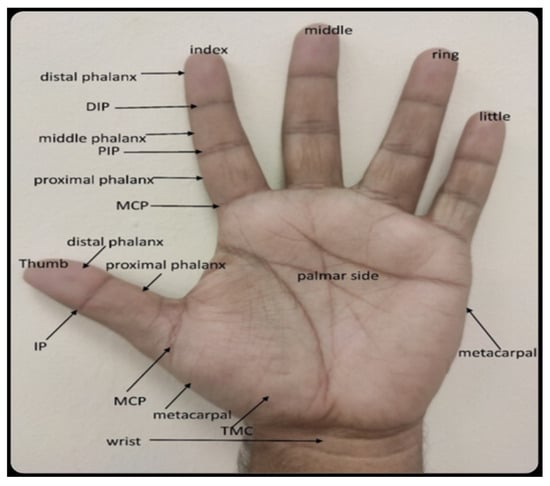
Figure 1.
Anatomy of the human hand.
The DOFs associated with the index finger are flexion/extension and abduction/adduction motions. It is identified from the literature that flexion/extension motions of the fingers are the most important motions required for performing activities of daily living (ADL) [1]. Hence, the device is considering only the flexion/extension motion of the index finger for kinematic analysis, and is shown in Figure 2.
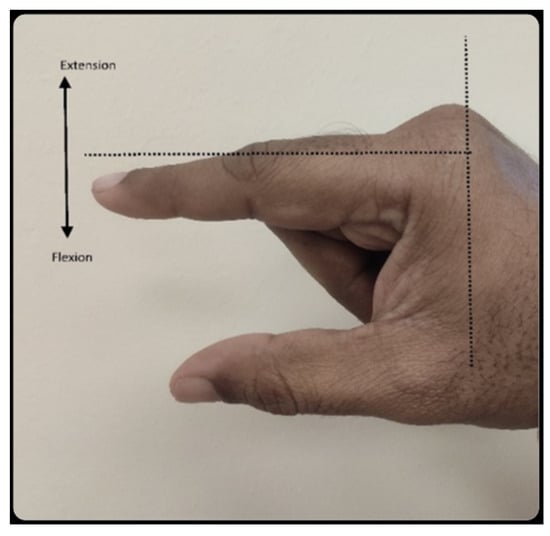
Figure 2.
Flexion/extension motions performed by the index finger.
3.2. Trajectory of Index Finger
In this project, the index finger of a healthy subject is taken as a reference to design the rehabilitation device using the four-bar mechanism and to validate it. There are five recommended simple exercises for performing on hand in stroke-affected patients so that they can regain back dexterity. These are palm up and down movement, wrist bend movement, grip and release pen, pen spin, and finger curl, as mentioned in [20]. This project considers the exercise ‘finger curl’ to be performed using the exoskeleton robot. In order to perform this exercise, the patient has to make little “O’s” with the index finger and thumb by bringing the tip of the index finger to the tip of the thumb and pinching and then releasing and repeating the exercise several times. This exercise is shown in Figure 3a.
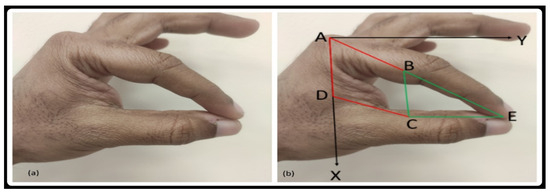
Figure 3.
(a) Finger Curl exercise for stroke patients, (b) Four-bar mechanism attached to the lateral side of the finger.
In order to perform this exercise using the robot, the trajectory of the index finger has to be found while performing the finger curl exercise. In Figure 3b, the four-bar mechanism (ABCDE) is placed at the lateral side of the index finger (but not attached to the hand) so that it helps to perform a finger curl exercise for stroke-affected patients. AB is the input link, BCE is the coupler, CD is the output link, and AD is the fixed link of the four-bar mechanism.
The length of the index finger can be measured easily using a measuring scale. The distance from the MCP joint to the tip of the index finger gives the total length of the index finger. To find the joint angles while performing the finger curl exercise an open-source software ‘Angulus’ Version: 4.0 is used. It can be downloaded from Play Store and installed in any smartphone. This software measures angles on images and videos. Thus, the joint angles of MCP, DIP, and PIP joints are found for the index finger at three different positions while performing the finger curl exercise. Then using the index finger length and its joint angles the trajectory is plotted using MATLAB R2022a software (MathWorks, Natick, MA, USA). The joint angles measured using Angulus with respect to the Y-axis are shown in Figure 4 for three different positions while performing a finger curl exercise. Figure 4a–c is the first position, Figure 4d–f is the second position and Figure 4g–i is the third position.
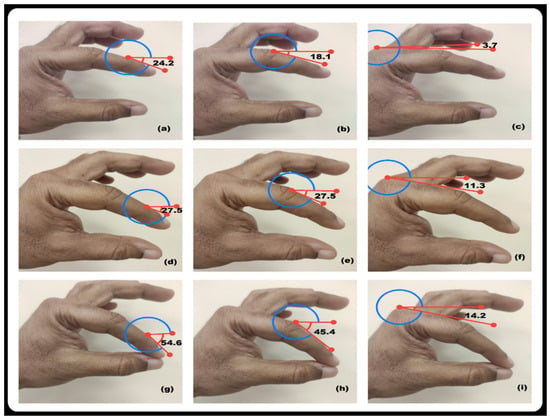
Figure 4.
Joint angles measured during finger curl exercise (a–c) Joint angles measured at first position, (d–f) Joint angles measured at second position, (g–i) Joint angles measured at third position.
The total length of the index finger for the test subject is 94 mm. The lengths of finger phalanges of the test subject and the total ROM of the MCP, DIP, and PIP joints are given in Table 2. Kyung-Sun Lee et al. [21] performed a literature review for the ROM of the index finger flexion and found the mean (standard deviation) for the MCP joint to be 80 (13), PIP joint as 104 (5), and DIP joint as 68 (11).

Table 2.
Length of phalanges and ROM of the index finger joints.
A one-DOF joint is considered as the revolute joint in kinematic analysis. Flexion/extension motion of the MCP joint is only considered because this is the most important motions for performing activities of ADL. Hence, the index finger has three one-DOF joints. The kinematic model of the index finger is shown in Figure 5.
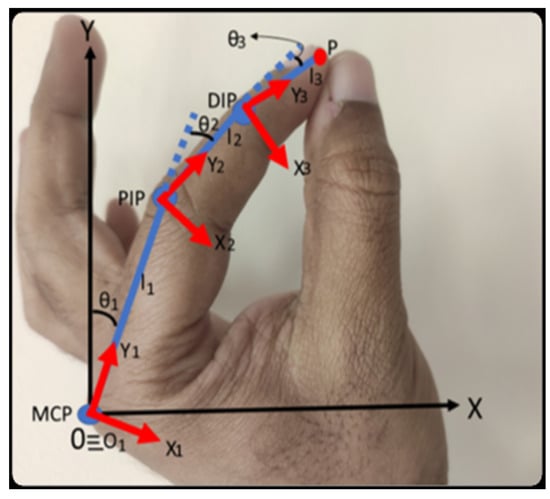
Figure 5.
Kinematic model of the human index finger.
The coordinate frame (X, Y) represents the global coordinate frame. The coordinate frame (X1, Y1) is attached to the MCP joint and coordinate frame (X2, Y2) is attached to the PIP joint and coordinate frame (X3, Y3) is attached to the DIP joint. The Homogeneous transformation matrix (for a simple rotation about Z-axis) used to find the workspace of the index finger is given as [23]
The ‘θ’ denotes the ROM of joints. l1, l2, and l3 denote the length of proximal, middle, and distal phalanges. denotes the homogeneous transformation between frames (X, Y) and (X1, Y1). Similarly, denotes the homogeneous transformation between frames (X1, Y1) and (X2, Y2), and denotes the homogeneous transformation between frames (X2, Y2) and (X3, Y3). denotes the vector representing the position of P from (X3, Y3).
The final transformation ( is obtained by multiplying all the individual transformation matrices as
The workspace of the index finger is plotted by Equation (1) using values in Table 3, and is shown in Figure 6a. θ1, θ2, and θ3 are calculated using the values obtained for joint angles measured during finger curl exercise from Figure 4. Then, the three fingertip positions (P1, P2, P3) of the index finger while performing the finger curl exercise are plotted in Figure 6b and their values obtained using Equation (1) are given in Table 3.

Table 3.
Joint angles and fingertip positions.
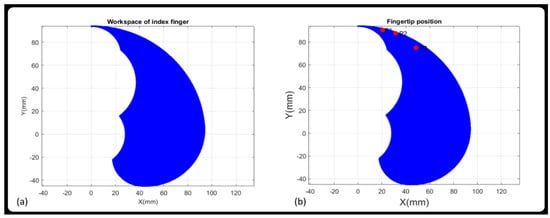
Figure 6.
(a) Workspace of the index finger, (b) Fingertip positions.
Thus, the trajectory of the index fingertip passes through these three points (P1, P2, and P3, denoted in red color) in Figure 6b. The obtained results clearly indicate that the trajectory of the index fingertip falls within the workspace of the index finger, which in turn satisfies the efficacy of using Angulus software.
In [24], a study aimed to evaluate the validity and reliability of Angulus software for measuring metacarpophalangeal (MCP) joint ROM and wrist ROM was performed. The study was conducted on 64 volunteers who had no prior joint problems. Angulus software was compared with a physical device called a goniometer. It was found that Angulus is a reliable and valid alternative to goniometer. One of the limitations of Angulus software found is, it is difficult to match the points on the photograph with the anatomical signs, which an experienced clinician can do. Another limitation is holding the camera from the exact line of the evaluated joint. However, it depends on the person’s photographing skills and the patient’s compliance. In this project, the index finger joints were clearly visible, and did not face any issue in finding the joints. Also, there was no problem with the captured image on a smartphone. Also, in [25], it was concluded that by using this Android application, you can quickly and easily test the ROM, and this is more reliable than a goniometer for measuring the ROM of the wrist joint.
3.3. Trajectory of the Mechanism
A four-bar mechanism having a triangular-shaped coupler link is considered for tracing the trajectory of the index finger. Thus, the trajectory of the coupler should pass through the three index fingertip positions. This is a path generation problem and therefore the optimum link lengths of the mechanism should be found out. In order to find the optimum design of the four-bar mechanism, the position synthesis method used in [26] was initially performed. Using this method an optimum link length was obtained. The trajectory of the four-bar mechanism is shown in Figure 7a and the four-bar mechanism is shown in Figure 7b. The coupler end point (E) is at position 2 (P2) in Figure 7b.
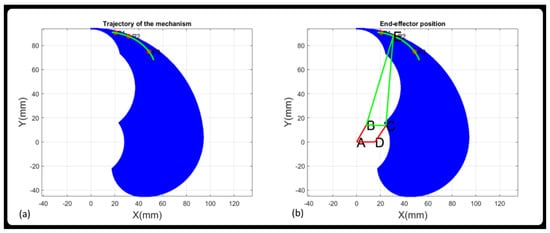
Figure 7.
(a) Trajectory of the mechanism, (b) End-effector position.
The drawback of three-position synthesis is that the designer cannot decide the range of the link lengths and the range of input angles of the four-bar mechanism. As a result, with the obtained link lengths via three-position synthesis, it may be very difficult to design a robot for rehabilitation. In Figure 7b, for the four-bar mechanism (ABCDE), the length of the links obtained by the three-position synthesis in MATLAB (computer-aided synthesis of mechanism) [26] is AB = 16.27 mm, BC = 16.42 mm, CD = 16.35 mm, AD = 15.42 mm, BE = 77.14 mm, and CE = 74.56 mm. The input angles (input parameters) used to obtain the link lengths are θ1 = 20°, θ2 = 60°, θ3 = 85°, and the exterior angle (<DCE) is δ1 = 78° (assumed). The obtained link lengths are very small in this case, which makes it difficult to manufacture and assemble. Also, the range of input angles for the four-bar mechanism has an effect on the obtained results while performing three-position synthesis. That is, if the input angles change, the link length changes arbitrarily. So, exact input angles are required, since the four-bar mechanism has numerous solutions, or else a trial-and-error method has to be employed, which, on the other hand, does not allow the coupler trajectory to pass through all three points. These issues have not previously been explained in detail by researchers while using three-position synthesis. As a result, researchers try to solve the path generation problem using three-position synthesis alone, which is time-consuming, without knowing by combining optimization technique with three-position synthesis will work for such a problem.
An open-source software ‘SALAR Mechanism Synthesizer’ software Version 1.0’ was used to optimize the link lengths of the mechanism. This software is specifically for path generation of the four-bar mechanism [27]. Four optimization techniques are present within this software. In this project, a multivariable constrained minimization technique in MATLAB is used (MATLAB function ‘FMinCon’). It provided results in 300 random restarts. The results obtained using SALAR are shown in Figure 8. In Figure 8, points on the reference path are set to three as it is a three-position synthesis problem. The type of problem is set as a non-prescribed timing problem, which means the coupler can reach the three points at any arbitrary input angle but within the specified range. In SALAR, it is possible to input the lower bound and upper bound for the input angle. It is input as 0 to 3.14 radians (Lb θ2 (rad), Ub θ2 (rad)). The obtained input angles are 0.7070 rad, 1.1867 rad, and 1.4272 rad. Also, it is also possible to input lower bound and upper bound for link lengths. It is input between 40 mm and 60 mm for links AD, AB, BC, and CD. In SALAR, r1, r2, r3, and r4 denote the length of links AD, AB, BC, CD, and rcx, rcy denotes the position of the coupler point (E) from the origin of the coupler (B) along the X- and Y-axis. rcx and rcy range from −60 mm to 60 mm. In SALAR, Cx and Cy represent the three positions of the fingertip.
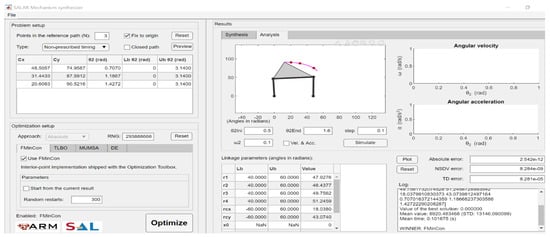
Figure 8.
Results obtained using FMinCon optimization setup in SALAR.
After obtaining the link lengths, the trajectory of the coupler point (E) is plotted in SALAR. Initial and final input angles for analysis are taken as 0.5 rad (θ2Ini) and 1.6 rad (θ2End) with step 0.1 and angular velocity 0.1 (ω2). The coupler points pass through the three fingertip positions with a very small absolute error of 2.542 × 10−12. The absolute error is the error in distance between the desired points and those obtained using a synthesized coupler.
In [27], it was identified that SALAR is a valuable tool in terms of accuracy, and convenience. The results obtained using SALAR were compared with the results for six different problems. In all these problems, different optimizers and cost functions included in SALAR were tested. In all these problems, in terms of absolute error, similar or better results were obtained in SALAR. In SALAR the results can be checked numerically and graphically. One of the limitations of using this software tool is that it can be used only for one kind of mechanism, a four-bar mechanism with a triangular-shaped coupler. Also, this software tool does not handle motion and precision point synthesis problems.
3.4. Mechanism Design and Prototyping
The optimized link lengths obtained in SALAR are given in Table 4.

Table 4.
Optimized link length.
Using the obtained link lengths, a CAD model of the mechanism is modeled in SolidWorks 2022 software (Dassault Systèmes, Vélizy-Villacoublay, France) as shown in Figure 9. A four-bar mechanism can be mounted on the left or right motor mounting. Right mounting is used to actuate the left index finger and left mounting is used to actuate the right index finger. The motor mountings have holes of the same diameter to attach the fixed link of the mechanism (which holds the motor) so that the motor shaft can be adjusted perpendicular to the MCP joint so that it can be used for a wide range of users. The coupler link has a ring (finger insert) at the end of it, to insert the index finger for performing finger curl exercise. A ring is used instead of a Velcro strap so that the finger follows the trajectory of the coupler without any delay due to the elasticity of the strap [9]. The thumb and hand (palmar side) need to be placed on the thumb rest and palm rest and should be tied using a Velcro strap as shown in Figure 10. Thus, the stand carries the entire weight of the hand.
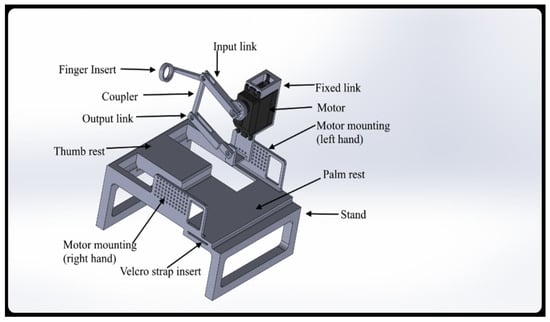
Figure 9.
CAD model of the robot.
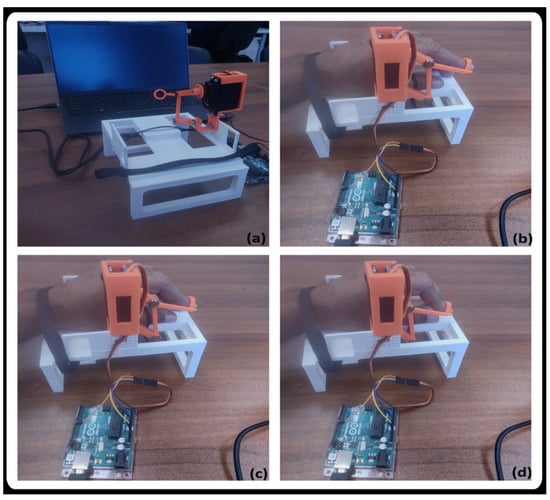
Figure 10.
Snapshots during the motion (a) developed prototype connected to a computer using Arduino board (b) coupler at position 1 (c) coupler at position 2 and (d) coupler at position 3.
Then, using SolidWorks 2022 motion analysis, the mechanism is simulated to check for collision detection. The input angle ranges from 20° to 180° without any collision and falls within the required range for performing finger curl exercise. Linkage thickness and width are taken as 8 mm and 7.8 mm for input and output links, respectively. The coupler link has a thickness and width of 4 mm and 7.8 mm, respectively. The screws and nuts used as revolute joints have size M5 with a length of 8 mm and are made of brass.
Chaparro-Rico et al. [28] used CAD simulation software to geometrically demonstrate the prototype for knee rehabilitation. Then, using ANSYS simulation software (Ansys, Inc., Canonsburg, Pennsylvania), deformation analysis was performed to identify the behavior of the mechanism. Cafolla et al. [29] used the CAD model of the human spine to perform simulation in a SolidWorks FEM environment and found it suitable for reproducing the natural movement of the human spine.
In the proposed work, the CAD model of the four-bar mechanism was performed in SolidWorks software according to the design parameters obtained from the SALAR mechanism synthesizer software. Motion study was performed in SolidWorks after assembling the individual parts. A motor was used to drive the input link of the mechanism. The output link of the mechanism collided with the stand during its trial, and hence some portion of the stand was extruded, as seen in Figure 9, to make it free from collision. Then, kinematic simulation was performed using the SALAR analysis module. During analysis, the trajectory of the mechanism was plotted. The error difference between the coupler curve and the trajectory of the index finger was negligible. Thus, the obtained design parameters were satisfying. SALAR has a GUI, which allows the results obtained to be checked numerically and graphically.
Then, using the FLASHFORGE Creator 3 series 3D printer (Zhejiang Flashforge 3D Technology Co., Ltd., Jinhua, China), each part is printed and then assembled. The material used is Poly-Lactic-Acid (PLA) material by B2N 3D filament with a diameter of 1.75 mm, temperature ranges from 190 to 230 °C, and speed of 50 mm/s. The extruder temperature is set to 215 °C and the bed temperature is set as 60 °C while printing.
FeeTech FT5316M servomotor (Shenzhen Feetech RC Model Co., Ltd., Shenzhen, China) having 180° rotation is used to actuate the input link of the four-bar mechanism. At 4.8 V, it has a speed of 0.18 s/60 degrees and a torque of 14.4 kg·cm.
This motor torque is sufficient to lift the index finger against the gravity. In the next Section, static force analysis was performed to validate the input torque. The weight of the motor is 56 g. This motor is fixed to the four corners of the fixed link of the four-bar mechanism using nuts and bolts. The motor shaft is attached to the input link of the mechanism. The motor is connected to the 5 V supply of Arduino board, which drives the exoskeleton. Initially, a program is uploaded to Arduino to run the motor, and later, the USB connecting the Arduino board can be inserted into any USB source for the functioning of the exoskeleton.
In Figure 10a, the entire setup of the proposed device is shown. It consists of a laptop for connecting the Arduino board. The exoskeleton is tested experimentally on the healthy subject using the developed prototype, as shown in Figure 10b–d. The exoskeleton followed the trajectory of the index finger very well. Initially, it moved from position 1 to position 2 and then to position 3. Then it reverses from position 3 to position 1 and repeats the procedure many times, which shows the efficacy of using a robot for repeated use.
Humans have the same two fingers of the same dimensions for both the hands. The same mechanism can be used for performing a finger curl exercise for the index finger of the right hand without changing the dimensions of the four-bar linkages. The only change is at the finger insert where it comes at the right side of the coupler for the right-hand index finger as shown in Figure 11a. Also, the device can be used for the middle fingers when performing flexion and extension motions. The coupler shown in Figure 11b can be used for the middle and index fingers when performing flexion and extension motions. It is understood, in Chowdary et al. [10], that the ring, middle, and index fingers follow the same trajectory and move in the same plane when they perform flexion and extension motions. Hence, another finger insert for the middle finger can be attached to the existing finger insert of the index finger when performing flexion and extension motions.
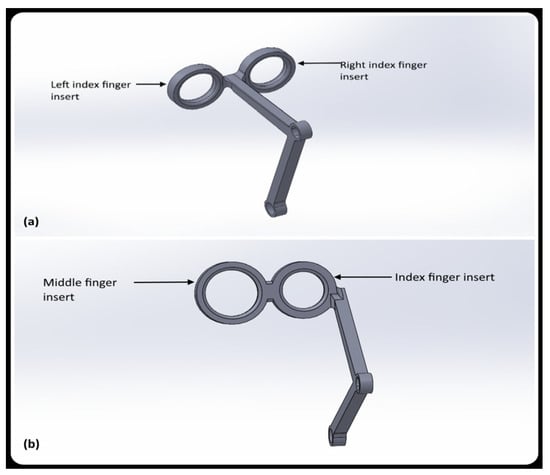
Figure 11.
(a) Coupler for left-hand index finger and right-hand index finger when performing finger curl exercise. (b) Coupler for middle finger and index finger when performing flexion and extension motions.
The proposed exoskeleton device can be adapted to various finger sizes and for both hands by easily customizing it. It is known that the most difficult part in the design and development of an exoskeleton for index finger rehabilitation is finding the trajectory of the index finger and the dimensional synthesis of the four-bar mechanism. To make it easier, two different open-source software are used. The first software gives the positions of the index finger at three different positions. This is then input to the second software. Usually, any optimization technique is required to solve the dimensional synthesis but here the software has a built-in optimization tool. Once the dimensions of the four-bar mechanism are obtained, the modeling of the links can be performed using CAD software. Since the proposed device uses only one four-bar mechanism, only four links need to be modeled. The fixed link of the four-bar mechanism that holds the drive requires only minimum alteration since it has a default size to keep the motor. For the other three links, only the link lengths will change. These changes will only be within a small range. Due to the small dimensions of the links, manufacturing them using a 3D printer will take only a few hours. Here, more time will be taken to manufacture the stand. The stand, which comes along with the device, can be used for all adults with no modifications, since the stand has mountings for drive, which can be adjusted to any height. For all children, another modified stand will solve the issue.
3.5. Design of Finger Insert
The design of the finger insert is important to obtain the desired ROM for all the finger joints. Different finger inserts were modeled to identify the best design that could produce the desired ROM.
A dummy model of the index finger was attached to the finger insert and mobility of the mechanism was tested, as shown in Figure 12. This was manufactured using a 3D printer in accordance with the specifications of the subject index finger. The trial showed difficulty in mechanism movement, which suggested changing the inclination angle of the finger insert. Thus, different finger insert was tested having a different inclination angle, and finally came up with a proper design for the finger insert, and the mechanism performed the finger curl exercise very well.
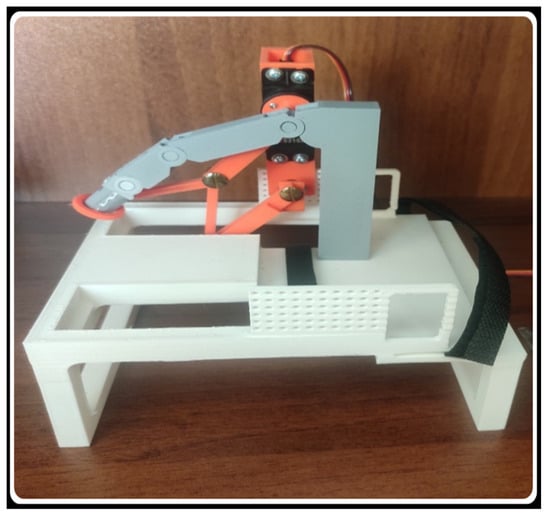
Figure 12.
Dummy index finger.
In Figure 13a, the finger insert modeled has a width of 5 mm. It can be seen that there is a bending of the finger happening near the DIP joint. The bending happened mainly due to the width and inclination of the finger insert. Thus, the desired ROM was not achieved. The kinematic model of the index finger is shown where the distal and middle phalanges are bent. In Figure 13b, the width of the finger insert was reduced to 3 mm. This design modification has eliminated the bending, but the desired ROM was not achieved. In this case, the distal phalange and the middle phalange are along a straight line without any relative motion between them. In Figure 13c, with a 3 mm width and the finger insert is now inclined at 20°, the ROM of the DIP joint provided the desired results for the finger curl exercise. In Figure 13d, further inclination was made to 45°, and thus it can be seen that the ROM for all joints has further improved than desired using the same four-bar mechanism, making a perfect ‘O’ shape when the tip of the index finger touched the tip of thumb finger.
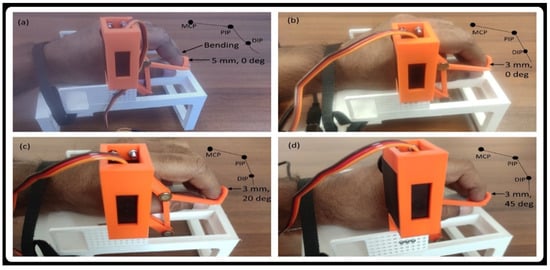
Figure 13.
Design parameters for finger insert: (a) 5 mm width and no inclination, (b) 3 mm width and no inclination, (c) 3 mm width and 20° inclination, (d) 3 mm width and 45° inclinations.
Thus, with the new design parameters (3 mm width and 45° inclination) for the finger insert, the proposed device performs rehabilitation of the index finger with good ROM for all finger joints and is shown for all three positions in Figure 14.
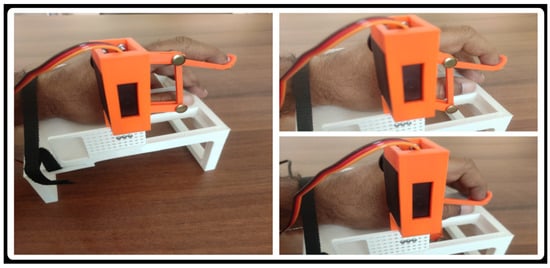
Figure 14.
Robotic-fingered exoskeleton performing index finger rehabilitation.
Most of the commercially available exoskeletons such as CyberGrasp, Flexohand, and Hand of Hope devices use Velcro straps. It was identified in [1] that the clearance between the exoskeleton and the finger can be eliminated when using Velcro straps. One of the main advantages of Velcro strap is that it can be customized to individual requirements. If there is any discomfort or irritation, foam pads or any type of foam can be used between the Velcro strap and skin [30]. In the proposed exoskeleton robot, a Velcro strap is used to keep the hand on top of the stand. If the patient has partial mobility, then there is no need for the Velcro strap at that position. Also, a Velcro strap was used to attach the thumb finger to the stand when performing the finger curl exercise. When the device performs flexion/extension motion, the Velcro strap can be avoided at this position. Thus, in the proposed exoskeleton robot, Velcro straps are not used in any places where there is motion and the Velcro strap does not support the device for performing rehabilitation motions. In [9], instead of a Velcro strap, rings are used. This will eliminate the delay during the motion, since the Velcro straps have material elasticity. It is mentioned in [10] that since Velcro straps slip, a mechanical connection between the finger and exoskeleton is not possible. Therefore, we have used a finger insert in the shape of a ring for mechanical connection in the proposed exoskeleton robot. In the future, the ring-shaped finger insert will be replaced by a cap-based finger insert. In [10], force sensors are placed inside finger inserts to sense the force applied by the patients. This will also allow some variations in the length of the finger for different patients. In the future, data on long-term comfort during repeated use of Velcro straps and finger inserts will be analyzed and also check skin irritation for prolonged use.
In rehabilitation, for patients with larger fingers or stronger resistance patients with severe spasticity, there is a need to change or redesign the finger insert. The finger insert should be capable of accommodating most portions of the finger and also should provide force feedback signals using built-in sensors. The torque requirements will not change in such a case, since we have used a more sufficient motor for such cases. Once, the feedback signals are available, a dynamic control system can be employed for the proposed device.
Software is used to find the trajectory of the index finger while performing a finger curl exercise. Another software is used to check if the one-degree-of-freedom mechanism followed the desired index finger trajectory. The results obtained show no deviation. Based on this, modeling of the mechanism was performed, and then performed an experimental study using the prototype. During dimensional synthesis, there was no possibility to add the finger insert during simulation in the software. Thus, while conducting the experimental study, the finger insert designed for inserting the index finger showed difficulty in holding the finger and performing the required range of motion of the finger joints. Thus, the finger insert was redesigned to obtain the best results. This was one of the main errors or deviations that occurred during the experimental study.
3.6. Static Force Analysis
The condition for equilibrium of a system of bodies (links of the mechanism) is the vector sum of all forces acting upon it is zero and the vector sum of the moments of all forces acting about an arbitrary axis is zero. This could be written as:
Using the free-body diagram for the links 2, 3, and 4 of the four-bar mechanism (Figure 15) and applying Equation (2), nine equations can be obtained.
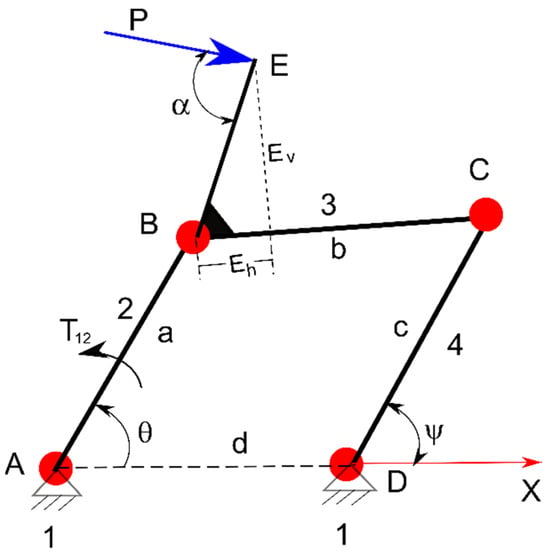
Figure 15.
Schematic of four-bar mechanism for static force analysis.
This system of nine equations can be written in matrix form as:
where A is a 9 × 9 matrix, X is a 9-dimensional vector of the unknown forces and torques, and B is a 9-dimensional vector, which contains the components of the external forces, i.e.,
are components of the external force; and is the torque needed to maintain static equilibrium.
The components of the matrix A are given in the following Table 5:

Table 5.
Components of matrix A.
Then, the vector of the unknown forces can be obtained by:
where is the inverse of A.
Here, the torque is of interest, which is the torque (provided by the motor) needed to maintain static equilibrium.
In [31], it is given that the index finger mass of an adult is between 30 and 35 g. Hence, the force acting due to this at the finger insert is calculated and found to be 0.34 N. This will act at joint E of the four-bar mechanism. On the other hand, a maximum force of approximately 6 N on the fingertip at the connections between the finger and exoskeleton is used in [1]. We will use this value of 6 N for our calculations.
Applying the external force P = 6 N (the axis of the force is perpendicular to the line BE, α = 90°) and using Equation (4) for angle θ = 60°, the following vector of the unknown forces is obtained: [−0.0088, −0.0036, 0.0088, 0.0036, 0.0033, 0.0060, 0.0033, 0.0060, 0.2706]. It can be seen that the obtained torque is = 0.2706 Nm For a similar case, but with the external force P = 0.34 N, the following vector of the unknown forces is obtained: [−0.0005, −0.0002, 0.0005, 0.0002, 0.0002, 0.0003, 0.0002, 0.0003, 0.0153]. All forces are in N and the torques are in Nm.
The resulting forces and torques are varied according to the input angle θ. Figure 16 shows the change in torque when the input angle θ varies from 30° to 120°, which covers the working range of the device. The external force is P = 6 N and its axis is perpendicular to the line BE (α = 90°).

Figure 16.
Torque variation during the motion of the mechanism.
It is possible for the axis of the external force P to change during the motion. For that reason, the graphics in Figure 17 show the change in the torque versus variations in the input angle θ (within the range [30°, 120°]) and angle α (within the range [50°, 110°]). The magnitude of the external force P at point E is 6 N, but the application axis varies (angle α varies).
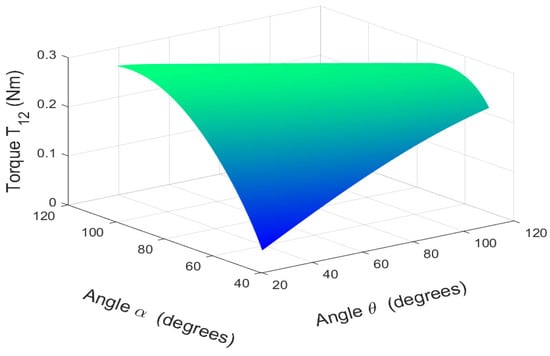
Figure 17.
Torque variation versus the input angle θ and angle α.
The maximal value of the calculated torque is 0.2916 Nm for the above-mentioned range of motion. These results correspond to similar research published by other authors. In [1], two four-bar linkages were serially connected for performing index finger rehabilitation and were actuated using two servomotors that each drive one of the four-bar mechanisms having a nominal torque of 216 Nmm. Also, in [10] a servomotor capable of producing 12.9 kg·cm of torque was used to actuate a four-bar mechanism for rehabilitating index and middle fingers coupled together using one finger insert.
In conclusion, it could be mentioned that the chosen motor for the device is capable of producing sufficient torque (1.4 Nm) in order to satisfy the maximum desired torque of 0.2916 Nm.
3.7. Electromyography-Controlled Finger Exoskeleton Robot
In this project, the servo motor is controlled via an EMG sensor. The EMG electrode board is secured to the palm of the patient’s active hand with a wristband. An electrode cable is used to transmit EMG signals through a signal transmitter board. An analog gravity three-pin cable is utilized to connect this board to Arduino. This setup makes use of the DFRobot Gravity Analog EMG Sensor by OYMotion (Zhiwei Robotics Corp., Shanghai, China). When the patient contacts the electrode with the finger of their active hand, the servo motor advances to the end position and returns to the starting position when released. The Arduino IDE’s serial monitor displays the minimum and maximum threshold values while the EMG sensor is idle and pressed. Figure 18 depicts the shift in threshold values obtained from myoelectric waveforms using the Arduino IDE’s serial plotter. The maximum threshold is set to 600. Table 6 provides an algorithm for controlling a servo motor using an EMG sensor.
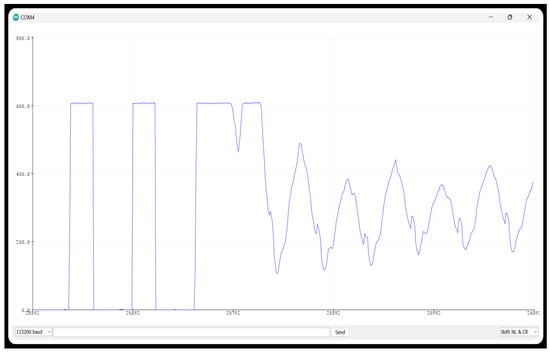
Figure 18.
Change in threshold values.

Table 6.
Algorithm for controlling the servo motor using EMG sensor.
In this project, it is suggested to use an EMG sensor if one of the upper limbs is active. Most stroke patients show severe muscle atrophy only in one of the upper limbs during a stroke. When using the EMG-based control system, if it has limitations in terms of latency and accuracy, when attached to the patient’s muscles with limited muscle control; in such cases, it is suggested to use an EMG sensor on the palm of the hand and use the fingers to apply force on the EMG electrodes. This is demonstrated in the video (Supplementary Material). In [32], EMG electrodes are placed at the back and front of the palm for measuring muscle activity. As is known, finger touches, grasps, and presses are the ways humans interact mostly with the real environment. Most technology devices struggle to capture the richness of the human touch. Thus, the EMG sensor acts as an input interface and enriches the patient’s interaction capabilities. There is minimal work due to finger contact and applied force. Thus, touch can extend the functionality of non-intelligent objects. In the future, we will estimate the force of the touch from EMG data [33]. In this way, the brain also learns from active therapy, thus the robotic device involves human intentions. In the future, it is intended that the patient controls the robot using their finger muscles through the EMG sensor. Also, sensors like thermistors and an inertial measurement unit (IMU) will be added for better control of the robot for stroke patients. Like an EMG sensor, a thermistor is used to detect a physiological response of the assisted finger motion. IMU can identify the angle displacements, velocities, and acceleration of the finger joints [11].
4. Discussion and Future Work
A custom-designed finger exoskeleton robot is proposed in this work for stroke-affected patients to perform rehabilitation therapy of index fingers at their homes (Supplementary Material). This exoskeleton robot performs finger curl exercises for the index fingers of both hands. The proposed device is the only device performing finger curl exercises for the index finger. The finger curl exercise is one of the most suggested exercises by clinicians for stroke patients to perform for fingers during rehabilitation therapy. Usually, all existing robotic devices perform motions like flexion and extension motions. When making alterations to the device, the proposed robot can be used for performing flexion and extension motions for the index and middle fingers as well. This device performs flexion and extension motions and not finger curl exercises when including another finger.
A four-bar mechanism is used to mimic the index finger for finger curl motion. The linkage mechanism is driven by a single actuator and has no attachment to the hand, which makes it unique from other devices used for finger rehabilitation. It is a novel device that has a lateral mechanism, which also is a stand-alone mechanism, which need not be attached to the human hand. The device is low-cost, easily transportable, and can be used for home rehabilitation. The device is experimentally validated, which showed effective rehabilitation for both index fingers, and therefore it is a bilateral mechanism.
Engineers and scientists use anthropometric data to design robotic devices to exactly fit a larger population. To manufacture prosthetic and orthotic devices, manufacturers rely on individual anthropometric measurements to customize devices for one’s needs. People have varied shapes and sizes and the mean value is used to develop devices, which sometimes fit exactly for a group of people [34]. It is possible to group a larger population according to age. In such cases, we have to design multiple devices with different sizes based on anthropometric data according to the age group.
Most of the robotic devices have rigid elements so that they do not fit a larger population due to variations in biological characteristics. Usually, the anthropometric data are collected manually, which is complex and time-consuming. Such data are not precise due to human error while measuring. Hence, automated techniques are most suited to collect data. Some of these techniques are using a 3D scanner, video processing, and using a coordinate measuring machine.
Video processing is considered to be the best solution when considering the cost, efficiency, and training required in collecting data. Nowadays, there are many open-source software available for processing recorded video. Birouas et al. [35] used a video-processing technique to collect the anthropometric data of a larger population. The accuracy of the data relies on video quality and factors such as good focus, resolution, frame rate, and lighting conditions. In such cases, more subjects on a larger scale are required to conclude the mean value of the data. Butzer et al. [17] considered the length and thickness of the fingers for a group of population in the same age group for designing a device.
In this proposed work, the length and thickness of the fingers are considered. Thickness is measured using a vernier caliper. An open-source software was used to record the length and ROM of the joints of the finger. This was performed by capturing an image of the index finger using a smart phone for three different positions while performing a finger curl exercise. This technique is very fast and reliable and the chance of human error is also not present. Using this technique, results are obtained very fast and are accurate, and the mathematical calculations involved in finding the trajectory of the finger are forward.
Then, ‘SALAR’, an open-source software to find the optimum length of the four-bar mechanism was used. This software has a graphical user interface (GUI) and the results can be obtained easily. The main convenience of this design is that it can be altered to any individual.. Also, 3D-printing technology is used to manufacture the device, which also is less time-consuming. By using these techniques, the device can be customized and made within a few days.
The proposed device is a novel device in terms of its wearability. The wearability issue is a main concern during the design of the exoskeleton and in this project this issue is managed properly as the device is not worn by the patient. The device has a stand that carries the entire weight of the hand.
The proposed robot has a fine control that can replicate the index finger trajectory and perform rehabilitation exercises like ‘finger curl’. After post-manufacturing, the exoskeleton was used to conduct an experiment on a healthy subject and was found to be successful in reproducing the desired trajectory of the index finger. In fact, the exoskeleton is designed in such a way that it can also be used for attaining 100% ROM of the index finger. Exoskeleton robots are usually evaluated by their mechanical design and therefore the proposed device is said to perform rehabilitation of the index finger very well [36].
A formal analysis was performed to find the trajectory of the mechanism to pass exactly through the index fingertip trajectory. Initially, the three fingertip positions of the index finger while performing finger curl exercise using the Angulus mobile application were found, and is shown in Figure 6b. Then, the workspace of the index finger using a homogenous transformation matrix was detected and plotted in MATLAB, as shown in Figure 6a. This proved that the index fingertip trajectory falls inside the workspace. Then, the design specifications of the mechanism using SALAR mechanism synthesizer software were performed computationally and the coupler curve of the mechanism was plotted. The coupler curve passed through the trajectory of the index finger with no error difference. Hence, it was clear that the mechanism would prove to be useful in producing the required motion with the obtained design parameters. Then, a collision test was performed using the CAD model in SolidWorks, and kinematic simulation was performed in SALAR mechanism synthesis software, which is shown in Figure 8. Also, a dummy model of the index finger was used to test the mechanism during its motion after manufacturing, and the results were satisfying.
The desired trajectory is the trajectory of the index finger. With a single actuator placed on the input link, the four-bar mechanism, which has one degree of freedom, follows the intended trajectory with good accuracy.
In order to find the trajectory of the finger, open-source software was used. One of the limitations of Angulus software is the difficulty of matching the points on the photograph with the anatomical signs [24]. Thus, the exact center of finger joints was identified based on one’s logic. Also, to solve the dimensional synthesis of the mechanism, it depended on another open-source software. The SALAR software tool used four different optimizers for the dimensional synthesis of the mechanism. Three of these optimization methods are stochastic population-based algorithms with global scope. In this project, the fourth optimization method, which is a local deterministic method combined with a multi-start component, was used [27]. This method provided the best results for the robot mechanism synthesis. Even though both software packages have been used by researchers for similar modeling and analysis, and proved their efficacy, it depends on certain assumptions [24,25,27]. Finally, in this project, the efficacy of the software tools was validated once again.
For this project, a control system is needed to produce the actuator commands needed to follow the intended path. Here, the Arduino actuator commands are written to rotate the motor shaft from 0.5 to 1.6 rad and vice versa, allowing the four-bar mechanism to move along the intended trajectory. These commands allow you to control the actuator’s speed as needed. Since the mechanism only has one degree of freedom, no sensors are needed to provide feedback regarding its orientation and position. Simple position control is all that is needed for our application; complex dynamic control is not needed. Optimal control deals with finding a control for the dynamical system when there is any initial disturbance and bringing it to equilibrium in the shortest time. In our case, we did not use any optimal control because there was no disturbance. We also did not use any sensors for feedback and optimal control requires some feedback, which is a drawback of optimal control. There are also no uncertainties like real-time perturbations in our system, and therefore a robust control is also not needed and used [37].
A four-bar mechanism was used for the robot. The input parameters used for the design of the mechanism are the three positions of the index finger when performing finger curl exercise. Any variations in the input design parameters can lead to different designs (link lengths) of the mechanism and different trajectories of the mechanism, respectively. The trajectory of the index finger is firm and any variations in input parameters will make the mechanism follow a different trajectory other than the finger trajectory. Then, the only variation possible is in the speed of the motor. This can be changed depending on the patient’s condition and recommendations by physicians. This change can be made in the program uploaded to Arduino for controlling the motor.
This device does not cause any injury or other harm to any patients using this device. Since the device is not fully attached to the human hand or finger, it is safe to use for rehabilitation. The exoskeleton robot proposed in this research has only one attachment point with the finger. It is possible to adjust the speed of the rehabilitation task by controlling the motor speed. Also, an emergency switch is provided to stop the device during any discomfort for the patients.
In this project, the exoskeleton is controlled by the user through an electromyography (EMG) sensor. Using the muscle signal to control the robot, the recovery of patients is very good when compared with passive robots, which do not use EMG. Through this method, the brain actually learns and the results will be good. This is called neuroplasticity in the brain. The brain does not learn anything from passive therapy. The conclusion is “if we have the robot itself it is not enough, the kit should include human intension”.
Personalization of the device is a big challenge while developing exoskeleton robots and it is well addressed in this work as it takes very less time to redesign with minor changes. The proposed device can also be used for rehabilitating the index and middle fingers of both hands when performing flexion and extension motions. The system setup costs are less than EUR 50, including the servomotor and Arduino.
Some shortcomings of the proposed exoskeleton are that the design is customized. It varies as the finger trajectory data vary from person to person. Hence, the CAD model has to be performed from scratch and mass production is not possible.
It is proposed that this device can be set up by the patients themselves, if there is mobility in one of their upper limbs. If not, it becomes difficult to use the device without any external support. Thus, a bystander has to assist during the rehabilitation task. In a real environment, the device does not provide any force feedback.
Then, another drawback of using this device in a real environment is that the finger can slip out from the finger insert if the finger muscles are weak. Hence, it is better to use it for patients with some mobility in their fingers. In the future, the ring-shaped design of the finger insert will be changed to a cap-based design to avoid slippage of the finger. The new design can accommodate some variations in the length of the finger for different patients.
Also, if there is any discomfort in the fingers due to the finger insert, long-term comfort during repeated use will be a concern in a real environment. Thus, using soft materials for designing the finger insert can eliminate this discomfort to some extent.
Also, there is a challenge in implementing EMG-based control for stroke patients with severe muscle atrophy. The reliability issue with the EMG-based control system in terms of latency and accuracy should be resolved when used in a real environment.
The proposed exoskeleton robot was experimentally validated on a healthy subject and showed good feasibility of the design. The hand was rested comfortably on the stand of the robot. In patients who have a total loss of mobility, it will be a matter of concern. It is thus recommended for patients who have partial mobility in the forearm or wrist, with no mobility in the fingers.
In the future, a brain–computer interface (BCI)-based challenge can be included for the patients. The hypothesis in the exoskeleton is to bring a connection between the brain and the hand. This is performed by BCI connection. These mechanisms are not just for therapy as they will also help understand the underlying mechanism of how the brain is working. The patient is not able to move because the brain is not functioning properly. Hence, it is best to use electroencephalogram (EEG) data. Thus, brain activity and muscle activity can be combined. Then quantitative reports on the state of recovery after each clinical trial can be sent to the doctors. Real-time interactive games can be embedded with the device to motivate patients and to enhance training outcomes.
In the immediate future, the exoskeleton will be tested on the index and middle fingers of a stroke patient when performing flexion and extension motions. In the future, the same exoskeleton can be used for combined actuation of all the four fingers (index, middle, ring, and little fingers) as all fingers move in the same plane. Also, the rigid link exoskeleton is to be replaced with the soft-bodied bionic robot. These robots have infinite degrees of freedom, unparalleled flexibility, agility, and safety [38].
Even though customization is easy for the proposed exoskeleton robot, it will be good if robots with varying anthropometric measurements, particularly for children or elderly patients are built. Then, in the future, the exoskeleton should provide feedback while performing rehabilitation tasks. In order to receive feedback, sensors like the force sensor, thermistor, and inertial measurement unit (IMU) should be placed in the robot. In the future, the exoskeleton should also perform rehabilitation tasks for all fingers including the thumb.
The proposed exoskeleton robot was experimentally validated on a healthy subject and shows good feasibility of the design. Next, we will develop a road map for clinical trials on actual stroke patients. Patients in the age group 40–60 will participate. Both male and female participants with left- and right-side stroke patients will be invited. Initially, index finger rehabilitation will be performed. Both the finger curl exercise and flexion/extension motions will be performed. This will happen at the home of the patients using the customized robot. The training will be intense for maximum time and should happen continuously at least three times a day. The stroke duration will be 90 days and the training duration will be between 8 and 12 weeks. The clinical outcome is to measure the finger grip strength [39].
This innovative design can also be extended as future work to perform flexion and extension motions for the index, middle, ring, and little fingers by making alterations. In this case, the little, ring, middle, and index fingers can be coupled. This device is not suitable for thumbs as their lengths and trajectory are very different compared to other fingers.
5. Conclusions
The objective of this project was to design a robotic device for the rehabilitation of the index finger in stroke-affected patients by performing a finger curl exercise. This robot is designed in a manner such that it can also be used for performing flexion and extension motions for the index and middle fingers. The index finger tip follows a three-point path. Angulus mobile application was used to obtain these points. SALAR software was used to perform the dimensional synthesis of the four-bar mechanism based on the index finger trajectory. Using this software, an analysis is performed to see if the mechanism travels along the intended path. Then, static force analysis was performed to validate the input torque required for the mechanism. Then, an EMG control is used in the proposed robotic finger exoskeleton for bilateral rehabilitation. The results obtained via simulation were experimentally validated to verify the accuracy of the results. The index finger trajectory is obtained from the kinematic model of the subject index finger. Since a one-degree-of-freedom mechanism is used to trace the index finger trajectory, the mechanism should follow the same (or approximate within certain boundaries) finger trajectory. This was then validated experimentally using the exoskeleton robot prototype by inserting the index finger of the same subject whose kinematic model of the index finger was used. The rehabilitation task was well executed by the prototype, which provided a better range of motion for the finger joints. In the future, this robot will be used for performing flexion and extension motions on the ring finger and little finger.
Supplementary Materials
The following supporting information can be downloaded at: https://doi.org/10.5281/zenodo.13643560. Video S1: Bilateral Stand-alone Robotic Motion-Assisted Finger Exoskeleton for Home Rehabilitation.
Author Contributions
Conceptualization, T.P.V. and T.K.T.; methodology, T.P.V. and T.K.T.; software, T.P.V. and T.K.T.; validation, T.P.V. and T.K.T.; formal analysis, T.P.V. and T.K.T.; investigation, T.P.V. and T.K.T.; resources, T.P.V. and T.K.T.; data curation, T.P.V. and T.K.T.; writing—original draft preparation, T.P.V.; writing—review and editing, T.P.V. and T.K.T.; visualization, T.P.V. and T.K.T.; supervision, T.K.T.; project administration, T.K.T.; funding acquisition, T.P.V. and T.K.T. All authors have read and agreed to the published version of the manuscript.
Funding
This work was financially supported by the European Regional Development Fund within the OP “Science and Education for Smart Growth 2014–2020”, Project CoC “Smart Mechatronic, Eco-and Energy Saving Systems and Technologies”.
Institutional Review Board Statement
Not applicable.
Informed Consent Statement
Not applicable.
Data Availability Statement
The data used to support the findings of this study are included within the article. If more information is needed, additional data will be available from corresponding author upon request.
Acknowledgments
This research was carried out at Institute of Robotics, Bulgarian Academy of Sciences, Sofia, Bulgaria.
Conflicts of Interest
The authors declare no conflicts of interest.
References
- Carbone, G.; Gerding, E.C.; Corves, B.; Cafolla, D.; Russo, M.; Ceccarelli, M. Design of a Two-DOFs Driving Mechanism for a Motion-Assisted Finger Exoskeleton. Appl. Sci. 2020, 10, 2619. [Google Scholar] [CrossRef]
- Analia, R.; Hong, J.; Mangkey, J.; Susanto; Pamungkas, D.; Soebhakti, H.; Sani, A. Use of the Human Walking Gait Cycle for Assistive Torque Generation for the Hip Joint Exoskeleton. J. Robot. 2021, 2021, 5561600. [Google Scholar] [CrossRef]
- Nishad, S.S.; Saxena, A.; Dutta, A. Design and Control of a Three Finger Hand Exoskeleton for Translation and Rotation of a Slender Object. In Proceedings of the ASME 2015 International Design Engineering Technical Conferences & Computers and Information in Engineering Conference, Boston, MA, USA, 2–5 August 2015; pp. 1–13. [Google Scholar]
- Gopura, R.A.R.C.; Kiguchi, K. Mechanical Designs of Active Upper-Limb Exoskeleton Robots State-of-the-Art and Design Difficulties. In Proceedings of the 2009 IEEE 11th International Conference on Rehabilitation Robotics, Kyoto International Conference Centre, Kyoto, Japan, 23–26 June 2009; pp. 179–187. [Google Scholar]
- Tejera, J.A.; Bustamante-Bello, R.; Ramirez-Mendoza, R.A.; Izquierdo-Reyes, J. Systematic Review of Exoskeletons towards a General Categorization Model Proposal. Appl. Sci. 2021, 11, 76. [Google Scholar] [CrossRef]
- Ahmed, T.; Assad-Uz-Zaman, M.; Islam, M.R.; Gottheardt, D.; McGonigle, E.; Brahmi, B.; Rahman, M.H. Flexohand: A Hybrid Exoskeleton-Based Novel Hand Rehabilitation Device. Micromachines 2021, 12, 1274. [Google Scholar] [CrossRef] [PubMed]
- Sheng, B.; Zhao, J.; Zhang, Y.; Xie, S.; Tao, J. Commercial device-based hand rehabilitation systems for stroke patients: State of the art and future prospects. Heliyon 2023, 9, e13588. [Google Scholar] [CrossRef] [PubMed]
- Troncossi, M.; Mozaffari-Foumashi, M.; Parenti-Castelli, V. An Original Classification of Rehabilitation Hand Exoskeletons. J. Robot. Mech. Eng. Res. 2016, 1, 17–29. [Google Scholar] [CrossRef]
- Orlando, M.F.; Behera, L.; Dutta, A.; Saxena, A. Optimal Design and Redundancy Resolution of a Novel Robotic Two-Fingered Exoskeleton. T-MRB 2020, 2, 59–75. [Google Scholar]
- Chowdhury, A.; Nishad, S.S.; Meena, Y.K.; Dutta, A.; Prasad, G. Hand-Exoskeleton Assisted Progressive Neurorehabilitation Using Impedance Adaptation Based Challenge Level Adjustment Method. ToH 2018, 12, 128–140. [Google Scholar] [CrossRef] [PubMed]
- Ceccarelli, M.; Morales-Cruz, C. A prototype characterization of ExoFinger, a finger exoskeleton. IJARS 2021, 18, 1–8. [Google Scholar] [CrossRef]
- Rehab-Robotics. Hand of Hope for Hand Rehabilitation. Available online: https://www.rehab-robotics.com.hk/hoh/ (accessed on 10 May 2023).
- Cortese, M.; Cempini, M.; Chiri, A.; Ribeiro, P.R.; Soekadar, S.R.; Carrozza, M.C.; Vitiello, N. A mechatronic system for robot-mediated hand telerehabilitation. TMECH 2014, 20, 1753–1764. [Google Scholar] [CrossRef]
- Polygerinos, P.; Lyne, S.; Wang, Z.; Nicolini, L.F.; Mosadegh, B.; Whitesides, G.M.; Walsh, C.J. Towards a Soft Pneumatic Glove for Hand Rehabilitation. In Proceedings of the 2013 IEEE/RSJ International Conference on Intelligent Robots and Systems IROS, Tokyo, Japan, 3–7 November 2013; pp. 1512–1517. [Google Scholar]
- Jiang, Y.; Chen, D.; Que, J.; Liu, Z.; Wang, Z.; Xu, Y. Soft robotic glove for hand rehabilitation based on a novel fabrication method. In Proceedings of the 2017 IEEE International Conference on Robotics and Biomimetics (ROBIO), Macau, Macao, 5–8 December 2017; pp. 817–822. [Google Scholar]
- Yap, H.K.; Lim, J.H.; Nasrallah, F.; Goh, J.C.; Yeow, R.C.H. A soft exoskeleton for hand assistive and rehabilitation application using pneumatic actuators with variable stiffness. In Proceedings of the 2015 IEEE International Conference on Robotics and Automation (ICRA), Seattle, WA, USA, 26–30 May 2015; pp. 4967–4972. [Google Scholar]
- Butzer, T.; Dittli, J.; Lieber, J.; van Hedel, H.J.A.; Meyer-Heim, A.; Lambercy, O.; Gassert, R. PEXO-A pediatric whole hand exoskeleton for grasping assistance in task-oriented training. In Proceedings of the 2019 IEEE 16th International Conference on Rehabilitation Robotics (ICORR), Toronto, ON, Canada, 24–28 June 2019; pp. 108–114. [Google Scholar]
- Milia, P.; Peccini, M.C.; De Salvo, F.; Sfaldaroli, A.; Grelli, C.; Lucchesi, G.; Sadauskas, N.; Rossi, C.; Caserio, M.; Bigazzi, M. Rehabilitation with robotic glove (Gloreha) in poststroke patients. Digit. Med. 2019, 5, 62. [Google Scholar] [CrossRef]
- Rahman, A.; Al-Jumaily, A. Design and Development of a Bilateral Therapeutic Hand Device for Stroke Rehabilitation. IJARS 2013, 10, 405. [Google Scholar] [CrossRef]
- Rehab, F. Full Body Exercises for Stroke Patients. Available online: https://www.flintrehab.com/stroke-exercises/ (accessed on 10 October 2022).
- Lee, K.S.; Jung, M.C. Ergonomic Evaluation of Biomechanical Hand Function. Saf. Health Work 2015, 6, 9–17. [Google Scholar] [CrossRef] [PubMed]
- Zheng, R.; Li, J. Kinematics and Workspace Analysis of an Exoskeleton for Thumb and Index Finger Rehabilitation. In Proceedings of the 2010 IEEE International Conference on Robotics and Biomimetics, Tianjin, China, 14–18 December 2010; pp. 80–84. [Google Scholar]
- Tsai, L.W. Robot Analysis: The Mechanics of Serial and Parallel Manipulator; John Wiley & Sons: New York, NY, USA, 1999. [Google Scholar]
- Özçelep, Ö.F.; Yavuzer, M.G.; Tunali, A.N. The Validity and Reliability of a Smartphone Application for Measuring Wrist and Metacarpophalangeal Joint Motion. Cureus 2024, 16, e58047. [Google Scholar] [CrossRef] [PubMed]
- Porkodi, J.; Karthik, V.; Mathunny, J.J.; Ashokkumar, D. Reliability and Validity of Angulus-Smartphone Application for Measuring Wrist Flexion and Extension. In Proceedings of the 2023 3rd International Conference on Artificial Intelligence and Signal Processing (AISP), Vijayawada, India, 18–20 March 2023; pp. 1–4. [Google Scholar] [CrossRef]
- Rattan, S.S. Theory of Machines; Tata McGraw Hill: New Delhi, India, 2009. [Google Scholar]
- Torres-Morenoa, J.L.; Cruzb, N.C.; Alvarez, J.D.; Redondob, J.L.; Giménez-Fernandez, A. An open-source tool for path synthesis of four-bar mechanisms. Mech. Mach. Theory 2022, 169, 104604. [Google Scholar] [CrossRef]
- Chaparro-Rico, B.D.; Castillo-Castaneda, E.; Maldonado-Echegoyen, R. Design of a Parallel Mechanism for Knee Rehabilitation. In Multibody Mechatronic Systems; Ceccarelli, M., Hernández Martinez, E., Eds.; Springer: Cham, Switzerland, 2015; Volume 25. [Google Scholar]
- Cafolla, D.; Marco, C. Design and Simulation of Humanoid Spine. In New Trends in Mechanism and Machine Science; Flores, P., Viadero, F., Eds.; Springer: Cham, Switzerland, 2015; Volume 24. [Google Scholar]
- Bortole, M.; Venkatakrishnan, A.; Zhu, F.; Moreno, J.C.; Francisco, G.E.; Pons, J.L.; Contreras-Vidal, J.L. The H2 robotic exoskeleton for gait rehabilitation after stroke: Early findings from a clinical study. JNER 2015, 12, 54. [Google Scholar] [CrossRef] [PubMed]
- Sashidharan, K.; Peter, W.J.; Storch, R.L. Relation between mouse button click duration and muscle contraction time. In Proceedings of the 30th Annual International IEEE EMBS Conference, Vancouver, BC, Canada, 20–25 August 2008; pp. 2299–2301. [Google Scholar]
- Dwivedi, A.; Kwon, Y.; McDaid, A.J.; Liarokapis, M. EMG Based Decoding of Object Motion in Dexterous, In-Hand Manipulation Tasks. In Proceedings of the 2018 7th IEEE International Conference on Biomedical Robotics and Biomechatronics (Biorob), Enschede, The Netherlands, 26–29 August 2018; pp. 1025–1031. [Google Scholar] [CrossRef]
- Becker, V.; Oldrati, P.; Barrios, L.; Sörös, G. Touchsense: Classifying Finger Touches and Measuring Their Force with an Electromyography Armband. In Proceedings of the 2018 ACM International Symposium on Wearable Computers, ISWC’18, Singapore, 8–12 October 2018; Association for Computing Machinery: New York, NY, USA; pp. 1–8. [Google Scholar] [CrossRef]
- Knudson, D. Fundamentals of Biomechanics; Springer: New York, NY, USA, 2007. [Google Scholar]
- Birouas, F.I.; Avram, F.; Tarca, R.C. Anthropometric measurements for hand rehabilitation robotic devices using video processing. In Proceedings of the 8th International Conference on Advanced Concepts in Mechanical Engineering, Iasi, Romania, 7–8 June 2018; IOP Conference Series: Materials Science and Engineering 444. p. 052028. [Google Scholar]
- Valayil, T.P.; Augustine, R.S. Kinematics and workspace analysis of a robotic device for performing rehabilitation therapy of upper limb in stroke-affected patients. Acta Bioeng. Biomech. 2021, 23, 175–189. [Google Scholar] [CrossRef] [PubMed]
- Fortuna, L.; Frasca, M.; Buscarino, A. Optimal and Robust Control: Advanced Topics with MATLAB, 2nd ed.; CRC Press, Inc.: Boca Raton, FL, USA, 2022. [Google Scholar]
- Zhang, Y.; Zhao, W.; Wang, N.; Lu, D. Development and Performance Analysis of Pneumatic Soft-Bodied Bionic Basic Execution Unit. J. Robot. 2020, 2020, 8860550. [Google Scholar] [CrossRef]
- Budhota, A.; Chua, K.S.; Hussain, A.; Kager, S.; Cherpin, A.; Contu, S.; Vishwanath, D.; Kuah, C.W.; Ng, C.Y.; Yam, L.H.; et al. Robotic Assisted Upper Limb Training Post Stroke: A Randomized Control Trial Using Combinatory Approach toward Reducing Workforce Demands. Front. Neurol. 2021, 12, 622014. [Google Scholar] [CrossRef] [PubMed]
Disclaimer/Publisher’s Note: The statements, opinions and data contained in all publications are solely those of the individual author(s) and contributor(s) and not of MDPI and/or the editor(s). MDPI and/or the editor(s) disclaim responsibility for any injury to people or property resulting from any ideas, methods, instructions or products referred to in the content. |
© 2024 by the authors. Licensee MDPI, Basel, Switzerland. This article is an open access article distributed under the terms and conditions of the Creative Commons Attribution (CC BY) license (https://creativecommons.org/licenses/by/4.0/).